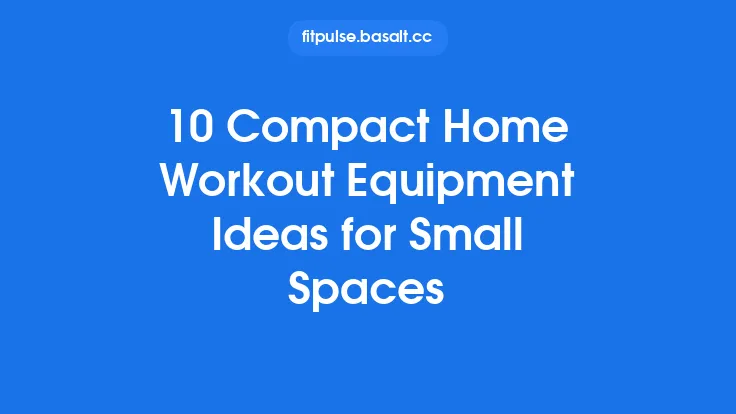Living in an apartment often means working with limited floor space, low ceilings, and a handful of pieces of furniture that double as obstacles and potential allies. Yet, a cramped environment doesn’t have to compromise the quality of your workout. By thoughtfully adjusting exercise form, selecting versatile equipment, and leveraging the structural features of your home, you can create an ergonomic routine that feels natural, efficient, and safe—even in the smallest of studios.
Assessing Your Apartment Layout
Before you even think about reps, take a systematic inventory of the area you intend to use.
- Measure the usable square footage.
- Use a tape measure or a smartphone app to record the length and width of the space.
- Subtract the footprint of any permanent fixtures (e.g., built‑in cabinets, radiators).
- Identify vertical assets.
- Walls, door frames, and sturdy railings can serve as balance aids or resistance points.
- Note ceiling height; low beams may limit overhead movements like overhead presses or high‑knee runs.
- Map traffic flow.
- Sketch a simple floor plan and mark the path you’ll take between exercises.
- Ensure you have a clear “reset” zone where you can step back to a neutral stance without bumping into furniture.
- Spot potential hazards.
- Loose rugs, cords, or low‑lying décor can become tripping points when you’re moving quickly.
- Relocate or secure these items before you start the session.
A clear mental picture of the space lets you anticipate where you’ll need to modify range of motion, adjust stance width, or incorporate support structures.
Choosing and Positioning Versatile Equipment
When square footage is at a premium, the right gear can make all the difference.
| Equipment | Why It Works in Small Spaces | Placement Tips |
|---|---|---|
| Adjustable dumbbells | Replace an entire rack; weight increments are compact. | Keep them on a low, stable shelf near the workout zone for quick access. |
| Fold‑out resistance bands | Provide resistance without bulk; can be anchored to doors or furniture. | Hang them on a hook behind a door; ensure the latch is secure before tensioning. |
| Collapsible yoga mat | Offers a defined surface that can be rolled up when not in use. | Store it vertically against a wall to free floor area. |
| Compact step platform | Enables step‑ups, elevated push‑ups, and plyometric drills without a full bench. | Place it near a wall for added stability; avoid positioning under low ceilings. |
| Wall‑mounted pull‑up bar | Utilizes vertical space; eliminates the need for a freestanding rack. | Install at a height that allows full arm extension without hitting the ceiling. |
When arranging equipment, keep a “work triangle” in mind: the distance between the start, the main movement zone, and the finish point should be short enough to maintain flow but long enough to avoid crowding. This principle, borrowed from kitchen design, helps you move efficiently between sets.
Modifying Core Movements for Tight Quarters
Many staple exercises can be reshaped to fit a modest footprint while preserving their biomechanical intent. Below are practical adjustments for common moves.
Squats and Variations
- Standard squat: If a full‑depth squat would cause your knees to brush a low coffee table, switch to a box squat using a sturdy, low platform (6–8 inches). The box provides a tactile cue for depth and prevents over‑travel.
- Goblet squat with dumbbell: Hold the weight close to your chest to keep the center of mass stable, reducing the need for a wide stance that could encroach on surrounding furniture.
- Wall‑supported squat: Lightly press the back of your elbows against a wall while performing the squat. This cue encourages an upright torso and limits forward lean, which is especially helpful when ceiling height restricts a deep hip hinge.
Lunges and Split Stances
- Static split squat: Instead of stepping forward and risking a collision with a wall, anchor one foot on a low step platform and keep the other foot planted on the floor. This eliminates forward motion while still loading the glutes and quads.
- Reverse lunge with a “mini‑step”: Use a folded towel or a small yoga block to elevate the rear foot slightly, allowing a deeper stretch without needing extra floor space.
Push‑Ups and Upper‑Body Presses
- Wall push‑up: Stand a few feet from a sturdy wall, place your hands on the surface, and perform a push‑up. This reduces the horizontal footprint and can be intensified by moving your feet farther from the wall.
- Elevated push‑up on a step platform: Place your hands on a low platform to decrease the angle of the movement, making it easier on the shoulders while keeping your body within a compact zone.
- Dumbbell floor press: Lie on a yoga mat and press the dumbbells upward. The floor acts as a natural limiter for the range of motion, preventing the elbows from dropping too low in a cramped area.
Core and Stability Work
- Standing Russian twists with a band: Anchor a resistance band to a door frame, hold the handle with both hands, and rotate your torso. This eliminates the need for a seated or floor‑based twist that could interfere with nearby objects.
- Single‑leg balance on a folded towel: The unstable surface challenges proprioception without requiring extra space; the towel can be rolled up and stored easily.
Leveraging Walls, Doorways, and Furniture for Support
Your apartment’s architecture can become an ergonomic ally when used correctly.
- Wall slides for shoulder mobility
- Stand with your back against a wall, elbows at 90°, forearms parallel to the floor. Slide your arms upward, maintaining contact with the wall. This movement improves scapular upward rotation without needing a bench or extra equipment.
- Doorframe rows
- Grip the top of a sturdy doorframe, lean back, and pull your chest toward the frame. Adjust the angle by moving your feet forward or backward, allowing you to control resistance while staying within a narrow vertical plane.
- Furniture as a balance aid
- A sturdy coffee table or sideboard can serve as a light support for single‑leg deadlifts or pistol squat progressions. Place a non‑slip mat underneath to prevent the piece from sliding.
- Ceiling‑mounted straps for suspension training
- If you have a strong ceiling joist, install a single anchor point for a suspension strap. This enables rows, chest presses, and core curls without a full rack. Ensure the anchor is rated for at least 250 lb and double‑check the joist’s integrity.
When using structural elements, always verify load capacity and stability. A quick test—apply a gradual force while monitoring for any flex or movement—can prevent unexpected failures.
Fine‑Tuning Range of Motion to Fit the Room
In a confined area, the full anatomical range of motion (ROM) isn’t always feasible. Rather than sacrificing form, strategically limit ROM while preserving joint health.
- Vertical clearance: For overhead movements (e.g., dumbbell shoulder press), stop the lift when the barbell or dumbbells are a few inches below the ceiling. This prevents shoulder impingement and protects the ceiling finish.
- Horizontal clearance: During lateral lunges, limit the step length to avoid hitting side walls. A shorter stride still activates the glutes and adductors if you focus on a controlled eccentric phase.
- Depth control: When performing hip‑hinge exercises like deadlifts, use a “box” or a folded mat as a tactile stop. This ensures consistent depth without needing to gauge space visually.
By establishing these “soft limits,” you create repeatable cues that keep the movement efficient and safe.
Maintaining Ergonomic Alignment While Adapting Form
Even though this article does not revisit the fundamentals of body alignment, a quick reminder of key alignment cues can help you preserve ergonomics during space‑saving modifications.
- Neutral spine: Whether you’re squatting on a step or performing a wall push‑up, keep the natural lumbar curve intact. Engage the core lightly to prevent excessive rounding.
- Knee tracking: In split‑stance variations, ensure the knee stays aligned with the second toe to avoid valgus stress, especially when the foot is elevated on a platform.
- Shoulder positioning: During wall‑supported exercises, keep the scapulae retracted and depressed to protect the rotator cuff.
These micro‑adjustments are easy to incorporate and do not require a separate “posture correction” discussion.
Managing Balance and Stability in Confined Areas
Balance challenges are amplified when you cannot step back freely. Here are strategies to keep stability under control.
- Anchor your base.
- Plant your feet shoulder‑width apart and distribute weight evenly across the entire foot. In a small space, a wider stance can feel more secure without encroaching on surrounding objects.
- Use visual cues.
- Mark a small “footprint” on the floor with tape. Align your feet to this marker for each set, ensuring consistent positioning and reducing the risk of drifting into obstacles.
- Progressive destabilization.
- Start with a stable surface (e.g., yoga mat). Once comfortable, introduce a folded towel or a balance pad for the final 2–3 reps of a set. This incremental approach builds proprioception without overwhelming the limited area.
- Hand‑based support.
- Lightly touch a wall or sturdy piece of furniture during single‑leg exercises. The contact point offers a safety net while still demanding core engagement.
Optimizing Workout Flow to Maximize Space
A well‑planned sequence minimizes unnecessary movement and keeps you within the ergonomic sweet spot.
- Cluster similar equipment.
- Perform all dumbbell‑centric moves together, then transition to band work. This reduces the need to shuffle equipment back and forth.
- Use “station” methodology.
- Designate three micro‑stations: (1) floor mat for core and bodyweight work, (2) wall/doorframe for pull‑type movements, (3) step platform for lower‑body loading. Rotate through each station with minimal travel distance.
- Time‑based circuits.
- Instead of counting reps, set a timer (e.g., 45 seconds on, 15 seconds off). This keeps the pace brisk and eliminates the temptation to wander around the room between sets.
- Pre‑set equipment.
- Before you start, lay out all needed dumbbells, bands, and the step platform in their final positions. This eliminates mid‑work interruptions that could cause you to bump into furniture.
Ergonomic Maintenance of Your Home‑Gym Gear
Even the most space‑savvy setup can become a source of strain if the equipment itself is misaligned.
- Dumbbell grip width.
- Choose handles that fit comfortably in your palm; oversized grips force the wrist into an unnatural extension, especially when space limits your ability to adjust hand placement.
- Band anchor height.
- Attach resistance bands at a height that mirrors the natural line of pull for the intended movement (e.g., chest height for rows, hip height for glute bridges). This reduces the need for awkward body angles that could stress the lower back.
- Step platform stability.
- Verify that the platform sits on a level surface. If the floor is uneven, place a thin rubber mat underneath to prevent wobble, which can compromise knee alignment during step‑ups.
- Wall‑mounted hardware.
- Periodically check screws and brackets for loosening. A loose anchor can shift during a pull‑up, forcing you to compensate with shoulder elevation—a common source of discomfort.
Routine checks keep your gear ergonomic and extend its lifespan, ensuring that your small‑space workouts remain smooth and safe.
Adapting Cardio Moves for Limited Footprint
High‑impact cardio often feels out of place in a compact apartment, but clever tweaks keep the heart rate up without sacrificing space.
- Low‑impact marching in place.
- Raise knees to hip level while swinging opposite arms. The vertical motion raises the heart rate without requiring forward or lateral displacement.
- Mini‑step jumps.
- Use a low step platform (4–6 inches) for quick, alternating foot taps. This mimics a box‑step but occupies only a few inches of floor.
- Shadow boxing with a wall.
- Stand a short distance from a wall and throw punches while rotating the torso. The wall provides a tactile cue for maintaining a stable base.
- Band‑assisted high knees.
- Anchor a light resistance band behind you at ankle level, then perform high knees. The band adds resistance without needing a larger running area.
These adaptations keep cardio sessions effective while respecting ceiling height and neighbor noise considerations.
Monitoring Form Fatigue in a Confined Environment
When space is tight, you may be tempted to push through the last few reps even as technique deteriorates. A few simple checks can help you catch form breakdown early.
- Visual self‑check.
- Position a mirror (or your phone’s front camera) at a slight angle so you can see your entire body during the movement. A quick glance every 5–6 reps can reveal subtle deviations.
- Tactile cue.
- Lightly place a hand on a stable surface (e.g., wall) while performing a single‑leg exercise. If you need to increase pressure to stay balanced, it may indicate fatigue.
- Breathing pattern.
- Consistent, diaphragmatic breathing often correlates with stable core engagement. A sudden shift to shallow chest breathing can signal loss of core control.
- Set a “form‑stop” rule.
- Decide in advance that if you cannot maintain the prescribed alignment for two consecutive reps, you’ll stop the set. This mental checkpoint prevents cumulative strain.
By integrating these low‑tech monitoring strategies, you preserve ergonomic integrity without needing additional equipment.
Summary of Practical Takeaways
- Map your space before you train; know the dimensions, vertical limits, and traffic flow.
- Select compact, multi‑functional gear and store it in a way that frees floor area.
- Adapt classic exercises (squats, lunges, push‑ups) with boxes, walls, or elevated surfaces to stay within your footprint.
- Use walls, doorframes, and sturdy furniture as intentional support points, not accidental obstacles.
- Set soft limits on range of motion that respect ceiling height and side walls while preserving joint health.
- Maintain core ergonomic cues (neutral spine, knee tracking, shoulder positioning) even when modifying form.
- Structure your workout flow into micro‑stations and time‑based circuits to minimize unnecessary movement.
- Regularly inspect and adjust equipment to keep it ergonomically aligned with your body.
- Choose cardio variations that require minimal horizontal displacement.
- Implement simple form‑monitoring checks to catch fatigue‑induced breakdowns early.
By thoughtfully integrating these ergonomic strategies, you can transform even the smallest apartment into a functional, safe, and effective workout sanctuary. The key lies in viewing space constraints not as limitations, but as design parameters that guide smarter movement and smarter equipment choices. Happy training!





